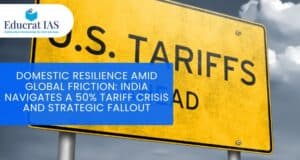India’s digital boom has come with an invisible yet toxic cost — electronic waste (e-waste).
As the third-largest generator of e-waste globally, after China and the USA, India produced 3.8 million metric tonnes (MMT) of e-waste in FY24 alone.
This surge represents a 151% increase since 2017, largely due to the shorter life cycle of gadgets and rising consumption of electronics. The country’s inefficient recycling systems are leading to massive losses — not only in terms of the environment but also precious resources like lithium, cobalt, and nickel, causing potential foreign exchange losses of over USD 1 billion by 2030.
This makes e-waste management a critical topic for UPSC GS Paper 3 (Environment) linking sustainability, policy implementation, and circular economy transitions.
India’s Policy Response: The E-Waste (Management) Rules 2022
The E-Waste (Management) Rules 2022 represent a turning point in India’s environmental policy framework.
They introduced Extended Producer Responsibility (EPR) — a globally recognized mechanism making producers responsible for the collection, recycling, and safe disposal of their products.
Key Provisions
- Expanded Product List: From 21 to 106 electronic items from FY24.
- Inclusion of Bulk Consumers: Shared accountability for safe disposal.
- Digital EPR Certificate Trading: Promoting transparency and traceability.
- Amendments (2023–2024): Introduced refrigerant management and EPR trading platforms for monitoring compliance.
However, despite progressive rules, enforcement gaps and infrastructure deficiencies continue to limit their effectiveness.
Challenges in India’s E-Waste Management Ecosystem
1. Enforcement Deficit
Weak regulatory oversight and limited audits have led to fake EPR certificates and data manipulation — with over 600,000 fraudulent plastic certificates detected in 2023.
2. Inadequate EPR Pricing
Low floor prices make formal recycling economically unviable, forcing recyclers to compete with informal, unsafe disposal practices.
3. Industry Resistance
Major manufacturers, including Daikin, Hitachi, and Samsung, have challenged EPR mandates citing regulatory overreach, slowing down compliance.
4. Infrastructure Disparities
Recycling centers are mostly concentrated in metros like Delhi, Bengaluru, and Mumbai, leaving smaller cities such as Chandigarh and tier-2 towns underserved.
5. Consumer Apathy
Low public awareness and untrained scrap dealers lead to improper disposal, causing severe pollution and health risks.
Analytical Perspective: Linking Policy and Ground Reality
India’s e-waste policy aligns with its Sustainable Development Goals (SDG 12: Responsible Consumption and Production).
However, without localized enforcement, industry cooperation, and public participation, the system risks becoming compliance-heavy but impact-light.
Reform Measures: Towards a Circular Economy
Educrat IAS recommends a multidimensional approach for policy improvement — integrating economic, environmental, and governance perspectives that UPSC aspirants must understand for GS Paper 3 answers.
1. Formalizing the Informal Sector
- Integrate rag pickers and informal collectors as certified E-Waste Heroes through skill development programs.
- Offer tax incentives and microfinance support to registered recyclers.
- Build linkages between urban local bodies and informal networks for traceable collection.
2. Strengthening the EPR System
- Define viable floor prices for EPR credits to ensure market stability.
- Introduce real-time digital tracking and independent third-party audits.
- Learn from South Korea’s EPR model, where producers fund recycling cooperatives.
3. Enhancing Enforcement and Accountability
- Increase capacity of CPCB and MoEFCC for strict monitoring.
- Empower urban local bodies (ULBs) to monitor e-waste flow within city jurisdictions.
- Penalize non-compliance and fake certificate trading through an integrated digital dashboard.
4. Boosting Public Awareness
- Launch nationwide campaigns using Self Help Groups (SHGs), RWAs, NGOs, and educational institutions.
- Disseminate information about authorized e-waste collection centers through local media.
- Integrate awareness drives into school curriculums under Environmental Studies.
5. Promoting Sustainable Product Design
- Encourage Design for Environment (DfE) — products that are easier to reuse, repair, and recycle.
- Mandate lead-free soldering (SAC alloys) to reduce toxic waste.
- Adopt the Right to Repair framework, as seen in the European Union, to discourage planned obsolescence.
6. Expanding Recycling Infrastructure
- Develop E-Waste Parks (like Delhi’s model) and E-Waste Clinics (like Bhopal’s) in all states.
- Establish E-Waste Banks for localized collection and redemption.
- Incentivize green startups and R&D centers focusing on battery and circuit recovery technologies.
7. Setting National E-Waste Recycling Targets
- Similar to the EU’s per capita targets, India should establish state-wise recycling goals and annual performance audits.
8. Investing in Research and Innovation
- Fund universities and private labs for developing eco-friendly battery recycling technologies.
- Encourage urban mining — extracting valuable metals from discarded electronics.
- Create a National Mission on E-Waste Innovation under the NITI Aayog framework.
Way Forward
India’s journey toward effective e-waste management is both an environmental imperative and an economic opportunity.
A robust system will not only conserve natural resources but also generate green jobs, reduce pollution, and boost the circular economy.
For UPSC aspirants, understanding this issue requires linking it to:
- Environmental governance
- Policy implementation
- Technological innovation
- Sustainable economic planning
With initiatives like Digital India and Make in India, sustainable waste handling becomes essential to ensure that growth does not come at the cost of the planet.
India’s e-waste challenge is a reflection of its growth story — fast, ambitious, and complex.
The E-Waste (Management) Rules 2022 and EPR mechanisms have created a strong foundation, but the real transformation lies in collaboration between government, industry, and citizens.
A future-ready India must focus on formalizing informal recyclers, strengthening compliance, and fostering public awareness — ensuring that digital growth translates into environmental sustainability.
Key Takeaways for UPSC GS Paper 3
Ethical dimension: linking technology use with environmental responsibility.
India generates 3.8 MMT e-waste annually, 3rd globally.
E-Waste Rules 2022 introduced EPR and expanded product coverage.
Challenges: weak enforcement, illegal imports, low awareness, industry pushback.
Solutions: stronger EPR pricing, infrastructure expansion, R&D, and awareness.





